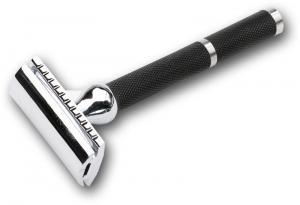The Beginning of the Modern Safety Razor
Before safety razors, straight razors were the common shaving tool. Of course, straight razors don’t have any safeguard against deep cuts. The idea of creating a safer razor, with blade guards, was piloted by Jean-Jaques Perret in 1770, but it wasn’t until 1888 that the development of the true, modern safety razor began. That year, the first American patent for a safety razor with a protective wire guard was given to the Kampfe brothers.
Soon enough, other manufacturers, like Gillette, were also developing and patenting designs for safety razors, and this new way of shaving was born.
All About the Blades
Safety razor blades, in their earliest incarnation, were not disposable and had to be sharpened frequently. But, the addition of disposable razor blades by King Gillette at the turn of the century changed the game and made the safety razor even easier to use. Gillette, of course, built an entire shaving empire on the disposability of blades with his loss-leader strategy (give away the razor, and profit on the replacement blades).
The company also made the savvy deal with the U.S. Army that resulted in Gillette safety razors becoming part of the standard kit for enlisted men sent to Europe during World War I. By the end of the war, over 3.5 million Gillette safety razors had been given to soldiers, helping convert a hefty amount of men to the Gillette brand.
Gillette’s blades were made of carbon steel through the 1960s—the carbon steel blades rusted quickly and needed frequent replacement. In 1965, however, the introduction and adoption of stainless steel blades in foreign markets required Gillette to follow suit. Today, most razor blades are stainless steel.
Safety Razor Head and Handle Improvements
Early safety razor heads were the classic “sandwich” type; they must be unscrewed from the handle to insert a new blade. The process of changing blades was made much easier by the introduction of the Twist-to-Open (TTO) design. With a TTO razor, the butterfly doors of the razor’s head are easily opened and closed with a quick twist of the mechanism at the bottom of the handle.
In 1958, Gillette also introduced an adjustable safety razor, with a new innovation: the ability to adjust the exposure of the blade to get a closer shave. Gillette’s adjustable safety razor included a ring beneath the razor’s head with labeled settings 1-9—setting 1 being the least aggressive shave, and setting 9 being the most aggressive.
Safety Razors Today
The basic design and function of the safety razor has changed little since the mid-20th century, but after the introduction of cartridge and disposable razors in the 1970s, the safety razor fell out of favor with most men. However, more recently, the safety razor is seeing a revival among men who are looking for not only a better shave, but also a more economic way to shave. With a safety razor, the primary investment is the razor itself; replacement blades are inexpensive. It’s also better for the environment, since the steel blades can be recycled.
Are you a fan of the safety razor for your own daily shave? If not, perhaps you should give it a try! The Gents Place has a great selection of safety razors and accessories.



